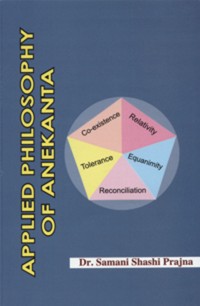As already noted the purpose of pointing out to this detailed classification of nayas is to show how differently the same object can be viewed by different individuals. However these different aspects are only partially true and since they are only partially true, they are not capable of being wholly true. They, however, cannot be rejected as wholly untrue also. In Jain texts we come across an interesting story of five blind men and elephant.[1] Here in the text Puruṣārtha Siddhyupāya, the Ācārya says, “I bow down to anekānta which is the root basis of highest scripture, which dispels the wrong notions about the elephant, of the persons born blind, and which removes the contradictions amongst all those who entertain one-sided or limited points of view. These different aspects can be illustrated by the reactions of some blind persons who were asked to go to an elephant and give its description after touching and feeling it. One who touched its legs described it like a pillar, one who touched its ears described it like a winnowing fan, one who touched the tail, described it like a rope and so on and so forth. Each one was right from his own standpoint because he could experience only a particular limb of the elephant and not the whole elephant. Each one of them was however, wrong because his description didn't confirm to the reality, which the elephant possessed. This reality could be comprehended only by one who could see the whole. The greatest contribution which the Jains have made to the world of thought is by their theory of nayavda and sydvda.[2]
Thus naya can be defined as a particular view point, a view point which gives only a partial idea about an object or a view which cannot over rule the existence of another or even a contrary view about the same object. The nayas are necessary in order to understand the partial true nature of a thing.Thus the Doctrine of philosophical standpoints are angles of vision or ways of approach and observation. These angles and ways give partial truths which contain grains of everlasting truth. The cumulative philosophical experience provided by the standpoints is extraordinarily wide-ranging and coherent and deep, and generates faith that truth is understandable. So it is clear that anekānta is a metaphysical doctrine, syādvād is a logical doctrine and nayavāda is a epistemological doctrine.[3] It demonstrates that truth is relative from the perspective of the perceiver and so has a subjective character and is difficult to articulate objectively.
3.3.3 Partial Truth of Individual Naya
 Dr. Samani Shashi Pragya
Dr. Samani Shashi Pragya

